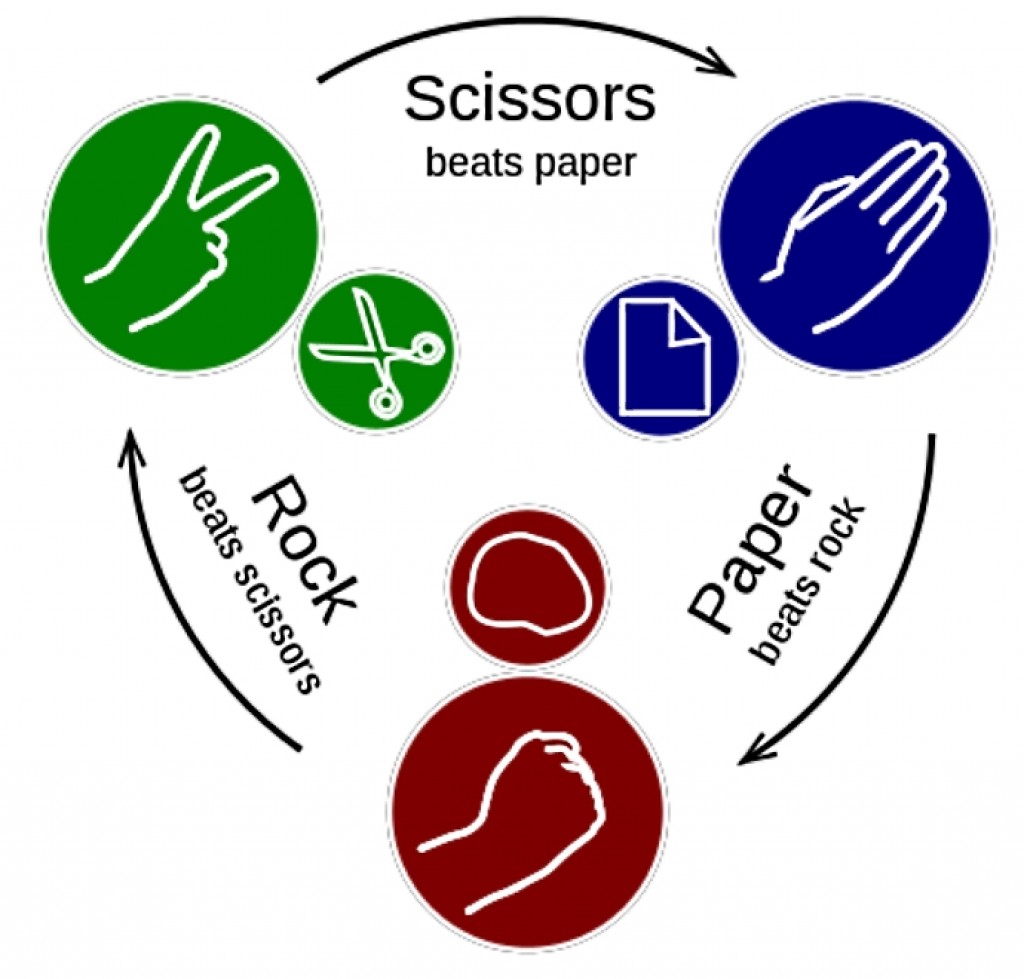Win the Rock Paper Scissors Game with a Secret Strategy
Like tossing a coin the odds of winning rock paper scissors game should depend on chance alone. You have a one in three chances of winning any round. However, whenever humans are involved knowing the outcome of previous rounds affects how humans choose the options in a non-random way.
If someone tosses six heads in a row, players start to wonder whether the toss is biased. Similarly, despite the odds not being affected by what has gone before, many people believe that after a sequence of six successive heads, the odds of a tail are higher than 50:50.
There are many tell-tale and subtle signs in hand and eye movements, facial expressions and body language that can be used to gain an advantage.
Several studies have shown that the outcome of the Rock Paper Scissors Game is not random and that these findings can be used to develop a strategy that will give you the edge.
Similarly, a computer program has been developed that enables a robot to win ever round of this game. Read on to learn how to win more often.
How Can A Robot Win the Rock Paper Scissors Game Every Time




A group of Japanese robotics engineers has created a robot that can play the game with humans. Annoyingly it wins every game and every round. How does it do it? It cheats!
The robot's video camera and software is designed to see what its opponent next move is very early on when the hand has just started to move. The 'move' to be made by the opponent's hand can be recognised and interpreted in milliseconds and the robot can respond with the perfect counter move.
The vision system recognizes the inception of a 'rock', 'paper' or 'scissors' hand shape very early on when the move is being made. The response is so quick that the hapless human cannot detect any delay and that the robot is reading and following the human's moves.
The researchers said the technology has many practical applications in helping robots to react to human movements in many ways.
Are the Rock-Paper-Scissors Game Results Truly Random?
A very detailed study has found that people do not play randomly, but follow hidden patterns that they may be unaware of. Players who know about these patterns can use them to their advantage to get a slight edge. Some examples are:
► Winners are more likely to repeat their winning action. If they win with 'rock' they are more likely to use 'rock' in the next move.
► Losers tend switch to the next move in the sequence "rock-paper-scissors". This means that if they lose with 'rock', they are more likely to try 'paper' with their next move. If they lose with 'paper', they are more likely to try scissors next time.
These findings and proposed strategies were revealed in a massive rock-paper-scissors tournament in China involving 360 students. These students were divided into groups of six.
Each player played a total of 300 rounds of rock-paper-scissors against other members of their group.
Classic game theory would suggest that players should completely randomise their choices. This means that their moves remain unpredictable and would be less likely to be anticipated by opponents. This would suggest that both players would select 'rock', 'paper' or 'scissors' with equal probability in each round. This would be applied irrespective of the outcome of the previous round. This is similar to 'heads and tails', where the probability of a head or tail is unaffected by the last coin toss and the last set of five or more coin tosses.
The overall outcome of the Chinese tournament showed that the probability of choosing 'rock', 'paper', scissors' was indeed one third of the time. This was what was expected if their choices were random.
However more detailed examination of the results showed several surprising non-random pattern of behaviour:
► Players who won a round tended to repeat their winning move more often than would be expected at random.
► Losers tended to switch to a different action and to choose the one they failed with less that one third of the time.
► Losers tended to move from 'rock', to 'paper', to 'scissors'. That is they followed the sequence in the name of the game, rather than being completely random.
► Previous experiments suggested that players unconsciously mimic the actions of their opponents. If their opponents have won with that move perhaps it offers some advantage.
► Players may also predict that their opponent is less likely to repeat the same more twice or three times in a row. This means that an opponent may expect the winner to choose one of the other options.
► Some people are quite good at reading the body language of their opponents and can predict their opponent's move before they have completed it. This is cheating like a robot. It can be very effective when children play the game and they can 'telegraph' their responses.
This 'winner-repeat - loser-shift" strategy is known in game theory as a conditional response.
Researchers suggest that this non-random pattern may be hard-wired into the human brain and is shown in many gambling and other games of chance.
Knowing this non-random patterns offers the following strategy for winners and losers of the previous move.
For Winners expect that:
► Your losing opponent will expect you not to repeat your previous move
► Your losing opponent will repeat your winning move
► Your opponent will be more likely to adopt the next move in the sequence rock, to paper, to scissors to rock etc.
For Losers expects that:
► The winner will repeat their winning move
► The winner may expect you to move in the sequence rock, to paper, to scissors
For both anticipating the non-random pattern and try to read the body language or your opponent.